In 1974, Oulipian
writer Georges Perec sat on a street corner in Paris for three days and
wrote down everything he saw. He was especially interested in describing
what he called the infraordinary, events "which [are] not noticed [and
have] no importance: what happens when nothing happens other than the weather,
people, cars, and clouds." What resulted was in parts a mind-numbing inventory
of buses, apple green 2-CVs, mopeds, pedestrians, pigeons, tourists ("photophagous
Japanese," he calls them), gestures, and rain, mixed in with occasional
moments of humor, surprising insight, and a funeral or two across the street.
These experiments have recently been translated into English by Marc
Lowenthal and republished in a slim book called An
Attempt at Exhausting a Place in Paris (Wakefield Press). The titular
'place' refers to Place Saint Sulpice, the busy corner in Paris he chose
for his experiment. Reading Perec's deliberately monotonous catalog made
me slightly uneasy. But perhaps precisely because of the monotony, I found
myself paying as close attention to the slightest changes in his writing—syntax,
repetition, and word choice—as he did to the non-happenings at Saint Sulpice.
Though the book is surprisingly enjoyable, it is still one of those
books that's more fun to think about than to actually read. What at first
appears to be a pretty obvious and simple experiment, upon further reflection,
reveals itself to be much more than that. It's a document of a place, yes.
But it's also a document of a time, and a document of the passage
of time, though that passage is only three days. Perec constantly questioned
the meaning of that passage:
What has changed here since yesterday? At first sight, it's
really the same. Is the sky perhaps cloudier? ... I couldn't say whether
the people I'm seeing are the same ones as yesterday, whether the cars
are the same ones as yesterday. On the other hand, if the birds (pigeons)
came (and why wouldn't they come) I'd feel sure they would be the same
birds.
Incidentally, I was trying to figure out how his observations—what
he noticed and decided to write down—changed from day to day. But I was
not the only one to do this. Perec was also constantly looking back at
his own process and questioning his methods. He was figuring out how he
wanted to conduct his experiment even as he was conducting it:
(why count buses? probably because they're recognizable and
regular: they cut up time, they punctuate the background noise; ultimately
they're foreseeable / The rest seems random, improbable, anarchic; the
buses pass by because they have to pass by, but nothing requires a car
to back up, or a man to have a bag marked with a big "M" of Monoprix, or
a car to be blue or apple-green, or a customer to order a coffee instead
of a beer...)
Thinking about all this made me want to visit Saint Sulpice myself. Then
I thought, why not? In fact, I had no other alternative. I had to continue
Perec's grand experiment by visiting the very corner where he made his
observations! Perec was interested in the passage of time. Well, it's been
38 years plus or minus some months now, and I will go to Saint-Sulpice
to see if anything has changed. Have the people become more ordinary? Have
the pigeons flown off for good? What, if anything, is the weather doing?
And I will make these observations not by sitting in that physical spot,
but by examining that spot from an instantaneous flash captured on top
of a little car with the word "Google" written on the side. Surely Perec
would have noticed such an out of the ordinary car, with a camera on top
of it? But maybe he's fallen asleep. Or maybe it's too out of the ordinary,
and he only notices ordinary, boring things.
DAY ONE
What's this? A bus,
you say? "The 87 goes to Champ-de-Mars," Perec says on page 8. "The 87
goes to Champ-de-Mars," Perec says again, just to be sure, on page 9. Now
I can repeat it: "The 87 goes to Champ-de-Mars," on page 2012! Sure enough
the alleged mobility of the bus that Perec loved so much, after 30 odd
years, has been called into question, as it seems not to have budged in
the interim years.
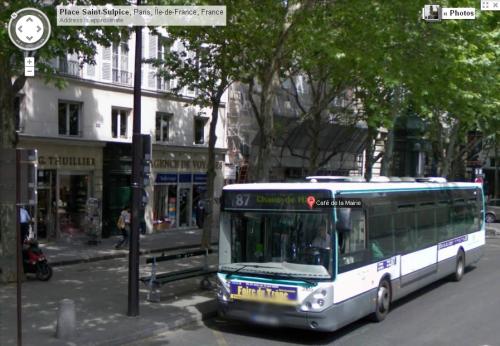
And the people! I count forty-seven people, when I do a quick 360.
Mopeds and bicycles. Perec rarely mentioned bicycles, but he did see
a few mopeds. One of them is going down the road right now.
Taxis line up across the street from the cafe. "Agence de V---" my view
is blocked. I click the arrows, going up and down the street.
A woman is standing in the bus, carrying several green plastic bags.
Another woman sits in the back of the bus.
I can see the sign now in this view, it says "Agence de Voyages," possibly
a travel agency? Among the list of things Perec mentions in the beginning
is a travel agency. I have a hard time believing that a travel agency has
survived so long.
A woman in a light brown trench coat is crossing the street.
The Café de la Mairie,
where Perec sat.
About 50 empty yellow foldout chairs in front, all facing out. Will
there be a concert across the street? No, not all of them are empty. Maybe
this is compact outdoor seating, for maximum capacity/profit?
Next to the cafe, two white trucks are at loggerheads.
'Sortie de Camions'.
My French is awful, I would be so lost in this country.
I wonder what Perec would think about Google Street View. He'd probably
write 500 books based on it.
A sign says 'Antiquaires.' Underneath it is a bench where three figures
are seated.
A narrow alley is blocked off from construction, one side of an old
building seems to be worked on. It looks like a government building, a
courthouse or something. Perec didn't mention a courthouse, that I remember.
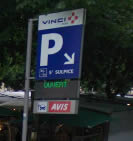
The letter 'P' is still here. Perec noticed this too, maybe because
his last name starts with a P.
I've heard of literary tourists making pilgrimages to Proust's hometown,
the one Combray was based on. Now I share their sense of re-looking, of
excitement mingled with inevitable disappointment.
More mopeds, everyone is wearing helmets: good.
The side of a blue truck advertises 'Bieres de Paris'.
Next to the 'P' and the parked taxis is what appears to be a subway
station. Was the subway here in 1974? Perec was oddly silent on this matter.
More trench coats, do the French love trench coats? Perec, incidentally,
noticed several.
Two men in light brown
jackets walk briskly. I can only assume, from their postures. One is
carrying a plastic bag, can't make out the contents. Are they trying to
catch one of these taxis?
The trees are leafy, green. I don't know when this photo was taken,
but probably spring, judging from the clothing and the lack of reddening
leaves.
Metal stalls. Are these stalls in some kind of street market? Google
won't let me go around back to see.
It strikes me that the limits of Street View has its benefits. Namely
that these constraints, though they prevent me from wandering off from
set tracks, also gives this whole endeavor that Oulipian spirit that guided
Perec and so many other great writers.
Oh my. It suddenly looks like these photographs were not taken sequentially.
This view of the street shows metal
stalls along the sidewalk but this one from few more feet over (meters?
they're metric over there, right?) shows white
tents in their place. Some kind of arts fair.

Two large women are crossing the street, one is dragging luggage
on wheels.
The light is red. A larger woman stands at the median.
A man in a blue shirt waits to cross the street with a manila envelope
in his left hand.
What, pray tell, has happened to all of the pigeons of 1974?
An ad reads 'GLAMOUR'. The light is red. A woman in a black top.
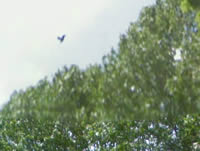
Oh, I have spotted a pigeon
in the air! Are you perhaps one of Perec's pigeon's great-great-grandchildren?
A smart car, parked in front of what appears to be residences.
I am moving down the street now, closer to Rue Bonaparte.
A woman in a white sleeveless shirt and a blue purse next to men in
coats. What is the weather like?
An apple green moped.
Perec mentions a fountain decorated with the statues of four orators,
but I cannot find it. Surely that would have survived if the travel agency
survived. Where is it? Maybe it has migrated north with the pigeons?
Still more Google-time has passed as I go down the road. Here the residential
building still looks normal,
but from a different view it is covered
in construction plastic.
A sign on the building says "traitement de facades," and even I can
figure that one out despite my poor French.
A woman with a very similar blue purse as the woman in the white sleeveless
shirt is walking under the scaffolding. But here she is wearing many more
layers and a scarf.
The light is green.
Oh, I found it! The fountain
and the statues! It seems that the white tents and (earlier?/later?) the
metal stalls had surrounded it and were obstructing its view.
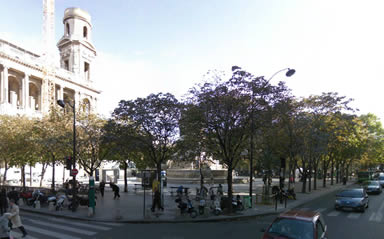
Why do I feel such relief to have found it?
It is too far to make out the pigeons. Let me navigate to a
better view.
Still no pigeons in sight.
Tourists are taking pictures.
At the end of the road, suddenly the white tents reappear. 'Alsacez-VOUS!
a Paris..' it says.
A woman in a fierce violet
jacket is walking fiercely. She is carrying an orange shopping bag.
Her body, in the act of shopping, has the propulsive thrust of an Olympic
gymnast. She is not ordinary or infra-ordinary, she is extraordinary.
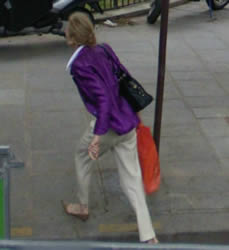
DAY TWO
I'm back on Google Street View, feeling re-energized.
Not far from the woman wearing the fierce violet jacket, in different
directions: Two bookstores,
surely one of these books
on display is Perec's An Attempt!
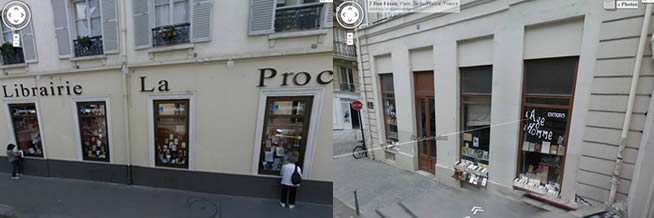
Incidentally, I just looked up 'photophagous'. It's not a word,
but apparently a play on the word phytophagous meaning "(esp. of an insect
or other invertebrate) feeding on plants". I wonder what the original pun
in French was.
Also, had a revelation during my break from Street View. There is no
clear indication that what I assumed was the subway station was indeed
the subway station. Maybe it is the parking lot that features so prominently
in An Attempt. If so, it would make sense that the cars 'dive' into
it, according to Perec. If it is not so, then where is the parking lot?
Also I have been re-reading Perec, and he briefly mentions a district
council building. I am pretty sure it is the one next to the Mairie that
is under reconstruction.
Police station. Police cars parked out front.
Spotted a 58 at the intersection of Rue Bonaparte and Rue de Vaugirard.
I don't remember Perec mentioning the 58.
I think I'm lost, so I'm going back to the Café de la Mairie.
Different
view of the outdoor seating. Looks almost like student desks. A group
of three elderly individuals (men or women? hard to tell with their faces
blurred) talking leisurely. Another man appears to be reading the newspaper.
In the opposite direction, a woman in a white jacket and yellow purse
walks by a green trashcan.
Looking back: the mopeds here are parked virtually equidistant from
each other, whereas they are usually bunched together.
In the middle of the street, a young man in a denim jacket is carrying
an instrument, and a woman on her cell phone has a yellow purse not unlike
the earlier woman.
I always assumed this bus was the same as the
87 in the front view, but the
side says 86.
The 86 just happens to be the most mentioned bus in An Attempt,
at least that is my impression.
"The 86 goes to Saint-Germain-des-Pres" Perec says.
And in fact, it is the 86 because the 87 from the front view has a different
side.

Two buses were in the same spot in two different views, and Google alternated
these two time frames within the same street.
I keep having to backtrack on things I've said as I circle this block
over and over again and understand more of what is going on and how Google
has spliced together images from different times. What at first seemed
apparent gives way to multiple deceptions.
I feel oddly like I know this block very well now, when in reality this
too is a deception. If I were to go to Saint Sulpice, I would be lost.
I would look for these people, always rooted in their designated spots,
as if they were landmarks, statues waiting for pigeons to land on, but
they would all be gone.
Borrowing an idea from René Daumal*:
how much can be gleaned from truly understanding one square block in Paris?
Perhaps, by deduction, the entire human race, and the world.
It occurs to me that Street View plays with time in a very interesting,
almost artistic manner, when in fact it is a random outcome based on the
different cameras' routes.
Three time frames:
metal stalls/antique market (the 86 is in this time frame)
white tents in the same spot (the 87 is in this time frame)
no tents or stalls, clear view to the fountain
There may be other time frames I am unaware of. I feel like a time traveler.
Here I can see the front
of the 86, finally.
Google Street View offers seeming continuity, a magic trick,
like a nod to traditional narrative. But in fact it is highly discontinuous
and jarring.
It offers up the idea that continuity is possible, while simultaneously
undercutting it.
Or maybe I am reading too much into this. A result of staring into the
computer too long.
MikiHouse is the name of the store on the corner of the residential
building that is (in some time frames) under construction.
How did I miss the pigeons
by the white tents yesterday?
A tour bus that says Knipschild on it.
I think that if I keep going up and down this street I will unlock some
kind of secret. I keep looking at the same people. Their frozen postures
hold so many potential stories. Then slowly I see new people. New things
that had escaped my attention previously. Each looking has more depth.
I see the same woman in the white sleeveless shirt, and I feel a sense
of familiarity, like we've already met.
A tourist in an all white get-up and a yellow umbrella crossing the
street.
Further down Rue Bonaparte: Mom with stroller, baby on back. Dad, presumably,
walking beside her, though most of his body is blocked.
Man with a baby blue book. Can't make out the title. White haired woman,
black coat.
Here is a sign for the metro. So it is a subway after all, and not a
parking lot. Where is the parking lot Perec refers to?
Two bright green street sweepers parked on a corner. A few construction
signs on the sidewalk. Corner of Bonaparte and Saint Sulpice.
Fierce woman in fierce violet jacket again. Feeling of familiarity.
In the other direction, Asian woman in a pink top and blue jeans. Taxis.
A silver Volkswagen with a sunroof. White tents.
A woman riding a bike very close to us. She's carrying a small green
purse.
A tourist with a backpack and another bag slung over a shoulder crossing
Saint Sulpice. Small Mercedes hatchback.
From this angle, another ramp leading down to the metro.
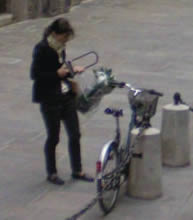
Starting over at the café, going down Place Saint Sulpice...
another
bookstore.
Woman with shopping bag running down the sidewalk. Why the hurry? I
see no taxis or buses nearby.
Across the street a woman
is locking her bike in front of the church. Or maybe she's unlocking
it. There's no knowing.
Wandering off from the square seems like such a luxury. So many new
sights and new people to see, easy eye candy. New sights without effort,
whereas in the square I have to strain my eyes to find something new (although
every time there is something I've missed before).
Rare man with unblurred
face, looking back suspiciously at the camera. I'm so used to seeing
the veil of the blur that it feels oddly wrong to look at his face. I feel
like a peeping tom, as if his face were obscenely naked. But I cannot stop
staring.
French taggers. A store
called JLR. A garbage truck. I've wandered kind of far now. It seems I
am driven to look and re-look without any endpoint in sight.
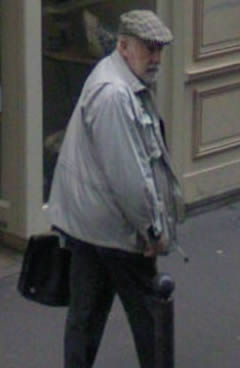
|